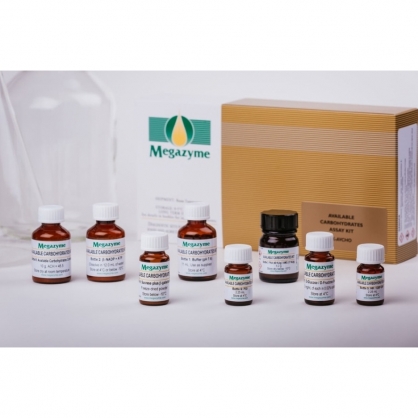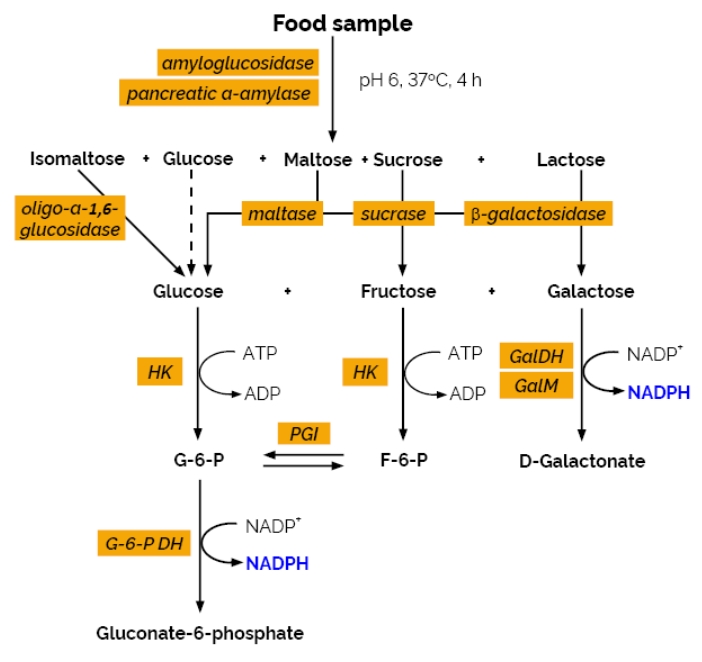- 背景資料
可獲得的碳水化合物(Available Carbohydrates)(簡稱AVCHO)定義為,不包括膳食纖維之總碳水化合物。故可獲得的碳水化合物包含了總可消化澱粉(Total Digestible Starch)(簡稱TDS)、麥芽糊精、蔗糖、D-葡萄糖、D-果糖和乳糖...等
⚠️備註⚠️
總可消化澱粉(Total Digestible Starch)(簡稱TDS)被定義為➡️4小時之內,可在人體小腸中消化和吸收的碳水化合物
- 測試樣品之準備(PREPARATION OF TEST SAMPLES)
Collect and prepare samples as intended to be eaten, i.e. baking mixes should be prepared and baked, pasta should be cooked etc. Defat per AOAC 985.29 if fat content is > 10% w/w. For high moisture samples (> 25%) it is desirable to freeze dry. Grind ~ 50 g in a grinding mill [C(a)] to pass a 0.5 mm sieve. Transfer all material to a wide mouthed plastic jar, seal, and mix well by shaking and inversion. Store in the presence of a desiccant. Grind wet samples (e.g. wet pasta) in a meat mincer to an homogeneous paste. Remove a representative sample for analysis and record weight. Separately, determine the moisture content of the wet sample and allow for the liquid volume in the calculations.
- 樣品之酵素分解(ENZYME DIGESTION OF SAMPLES)
Method 1. Procedure for analysing ~ 0.5 g of sample
(a) Accurately weigh approx. 0.5 g sample, correct to the third decimal place, into a 30 x 84 mm (40 mL) polypropylene tube [C(t)]. Record the weight. Add a 20 x 6 mm stirrer bar [C(n)] to each tube.
(b) Sample equilibration.— Wet the sample with 0.5 mL of 95% v/v ethanol (or IMS) [B(d)] and add 17.5 mL of maleate buffer, pH 6.0 [B(a)] to each tube. Cap the tubes and place them in the special polypropylene holder [C(u)] (Figure 2) on a 2mag Mixdrive 15® submersible magnetic stirrer [C(d)] in a water bath and allow the contents to equilibrate to 37°C over 5 min with stirring at 170 rpm.
(c) Incubation with PAA/AMG solution.— Add 2.5 mL of PAA/ AMG solution [A(3)], cap the tubes and incubate the reaction solutions at 37°C and at 170 rpm on the 2mag Mixdrive 15® submersible magnetic stirrer. NOTE: If using an (NH4)2SO4 suspension of this enzyme preparation [A(3)], add 1.0 mL of enzyme suspension and 1.5 mL of sodium maleate buffer [B(a)].
Method 2. Procedure for analysing ~ 1 g of sample
(using the incubation arrangemant employed for AOAC Method 2017.16 for TDF; RINTDF).
[NOTE: with Method 2, the number of samples that can be analysed with a kit will be halved].
(a) Accurately weigh approx. 1 g sample, correct to the third decimal place, into a 250 mL Fisherbrand glass® bottle [C(o)]. Record the weight. Add a 30 x 6 mm stirrer bar [C(n)] to each bottle (Figure 3, page 14).
(b) Equilibration with buffer.— Wet the sample with 1.0 mL of 95% v/v ethanol (or IMS) [B(d)] and add 35 mL of maleate buffer [B(a)] to each bottle. Cap the bottles and place them on a 2mag Mixdrive 15® submersible magnetic stirrer [C(d)] and allow the contents to equilibrate to 37°C over 5 min with stirring at 170 rpm.
(c) Addition and incubation with PAA/AMG solution.— Add 5 mL of PAA/AMG solution [A(3)], cap the bottles and incubate the reaction solutions at 37°C and at 170 rpm on the 2mag Mixdrive 15® submersible magnetic stirrer. NOTE: If using the (NH4)2SO4 suspension of this enzyme preparation [A(3)], add 2.0 mL of enzyme suspension and 3.0 mL of sodium maleate buffer [B(a)].
- DETERMINATION OF AVAILABLE CARBOHYDRATES
(a) Carefully remove 1.0 mL of the reaction solution at 240 min and transfer to 25 mL of cold water in a 40 mL polypropylene tube [C(t)]. Cap the tube, mix the contents thoroughly and store the tube at 4°C awaiting analysis.
(b) Transfer 2.0 mL of this solution to 2.0 mL polypropylene microfuge tubes [C(i)] and centrifuge at 13,000 rpm for 5 min.
(c) Analyse 0.1 mL aliquots of the supernatant solution as described in the table below. In this assay, lactose is hydrolysed to D-glucose plus D-galactose by b-galactosidase, sucrose is hydrolysed to D-glucose and D-fructose by sucrase (which has no action on fructo-oligosaccharides; FOS), isomaltose is hydrolysed to glucose by oligo-a-1,6-glucosidase and remaining maltose is hydrolysed to D-glucose by maltase. Free D-galactose, D-glucose and D-fructose are then determined.
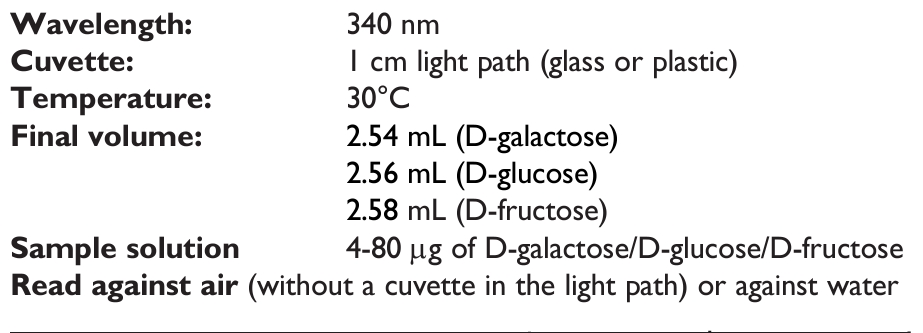
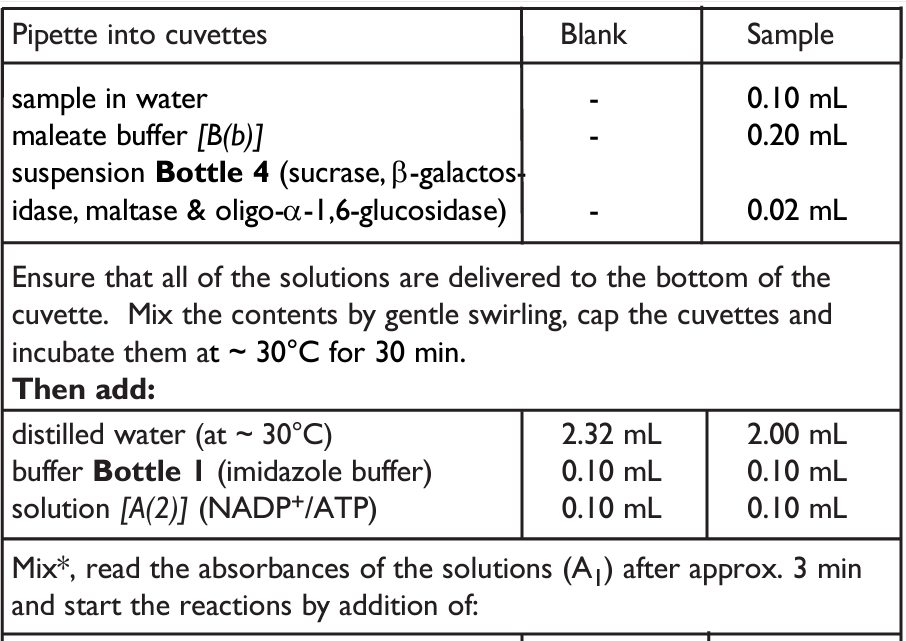
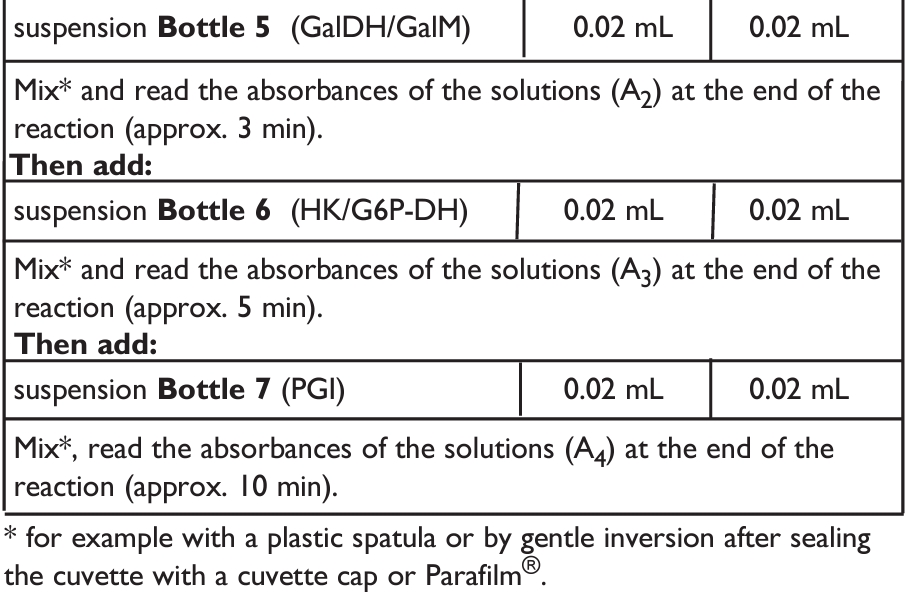
商品特色
商品規格
- 商品規格 (100個檢測反應)
Bottle 1:
Imidazole buffer (11 mL, pH 7.6) plus magnesium chloride and sodium azide (0.02% w/v) as a preservative.
Stable for > 2 years at 4°C.
Bottle 2:
NADP+ plus ATP.
Stable for > 5 years stored dry below -10°C.
Bottle 3:
Mixture of purified PAA (40 KU/g) and AMG (17 KU/g) (5.2 g).
Stable for > 5 years stored dry below -10°C.
Bottle 4:
Sucrase/maltase plus b-galactosidase and oligo-a-1,6-glucosidase. Suspension (2.25 mL).
Stable for > 2 years at 4°C.
Bottle 5:
Galactose dehydrogenase/galactose mutarotase.Suspension (2.25 mL).
Stable for > 2 years at 4°C.
Bottle 6:
Hexokinase plus glucose-6-phosphate dehydrogenase. Suspension (2.25 mL).
Stable for > 2 years at 4°C.
Bottle 7:
Phosphoglucose isomerase. Suspension (2.25 mL).
Stable for > 2 years at 4°C.
Bottle 8:
D-Glucose, D-fructose plus D-galactose standard solution (5 mL, 0.2 mg/mL of each sugar).
Stable for > 2 years; stored sealed at 4°C.
Bottle 9:
Available carbohydrates control (~ 10 g). AVCHO value shown on the label.
Stable for > 5 years at room temperature.
